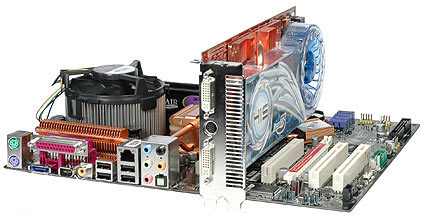Is nForce 650 the Mainstream Master?
Brute-Force Chipset Positioning
Although there are a variety of choices, the hunt for the ideal platform has become more difficult. In the past, there was only Intel's chipset portfolio and the offerings from Taiwan's chipset makers ALi/ULi, SiS and VIA. Over time, the graphics specialists ATI and Nvidia joined in with attractive chipset choices for the upper mainstream and the high end. These products offer enhanced feature sets such as support for multi graphics cards setups or comfortable tuning and overclocking options. This makes them more appealing to the consumer than the rather conservative Intel chipsets, but does the customer really benefit from the still increasing choice? AMD/ATI, Intel, Nvidia - mainstream or high-end?
For many years there was an unwritten law saying that the best chipset choice for an Intel processor usually is an Intel product. Indeed, most Intel chipset generations outperformed their competition or they offered a better feature set. Driver support from Intel has been reliable as well, so why bother about other chipsets?
For one, platform performance is no issue anymore, because the difference between the quickest and the slowest chipset is negligible. This means that it doesn't matter whether you get a motherboard with ATI's Crossfire Xpress, an Intel 975/965 chipset or one of Nvidia's nForce 600 products. Differences can be measured, but you cannot really notice them. If all you want is a decent platform, you may very well go for a reasonably cheap motherboard. Or in other words: In the mainstream, the platform choice tends to be decided by the particular product rather than the core logic a motherboard is based on.
The situation is different as you enter a particular market segment. If you evaluate chipsets with various usage models in mind, differences start to emerge. Motherboards for business PCs do not have to carry lots sophisticated components. Instead, these products need to be reliable and easily manageable. A long warranty and support period doesn't hurt either. Multimedia computers should have a plethora of interfaces and decent audio and video components. Enthusiast platforms are expected to overclock well and support all sorts of high-end features and hardware such as RAID storage, multiple graphics cards or the fastest processors and a lot of RAM.
Nvidia launched its nForce 680i SLI chipset for Intel processors in December 2006, and despite not being clearly faster than other products, it clearly is the most flexible platform for Core 2 Duo, Core 2 Quad and Core 2 Extreme processors. But it also comes at a high price. At the same time, Intel's 975X/P965 chipsets still offer higher RAID and interface performance. AMD/ATI has the Crossfire Xpress 3200 chipset for Core 2 processors, which is the Crossfire dual graphics counterpart for Nvidia's SLI-enabled chipsets.
Today we take a look at Nvidia's mainstream SLI chipset, the nForce 650i SLI Compare Prices on nForce 650i SLI Motherboards. How does it compare to the AMD/ATI or Intel chipsets?
Join our discussion on this topic
Get Tom's Hardware's best news and in-depth reviews, straight to your inbox.
Current page: Brute-Force Chipset Positioning
Next Page Chipsets For Core 2 Duo
Patrick Schmid was the editor-in-chief for Tom's Hardware from 2005 to 2006. He wrote numerous articles on a wide range of hardware topics, including storage, CPUs, and system builds.
